
10000 Results



Coders use the repeat block to repeat a silly dance for Scratch Cat using motion blocks. The purpose of this project is to introduce young coders to repeating algorithmic sequences in ScratchJr.
- Subject:
- Applied Science
- Computer Science
- Material Type:
- Activity/Lab
- Lesson
- Provider:
- Boot Up PD
- Author:
- Boot Up PD
- Date Added:
- 09/19/2019

This activity is designed for a primary classroom (outdoors & indoors) investigation where students collect and investigate soil samples and describe the soils, looking for similarities and differences. Students develop a method of recording the data colleted and can present the information gathered.
- Subject:
- Ecology
- Life Science
- Material Type:
- Activity/Lab
- Lesson Plan
- Provider:
- Science Education Resource Center (SERC) at Carleton College
- Provider Set:
- Pedagogy in Action
- Date Added:
- 01/20/2012
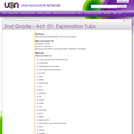
The focus of this lesson is to provide an opportunity for children to develop oral language skills and to record their oral language to share with others.
- Subject:
- Arts and Humanities
- Education
- English Language Arts
- Language Education (ESL)
- Language, Grammar and Vocabulary
- Material Type:
- Lesson Plan
- Provider:
- Utah Education Network
- Date Added:
- 10/22/2013
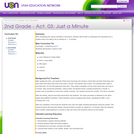
After completing the various activities in this lesson, students will be able to understand the importance for a healthy body to be able to do an activity for 1 - 5 minutes.
- Subject:
- Education
- Material Type:
- Lesson Plan
- Provider:
- Utah Education Network
- Date Added:
- 10/22/2013
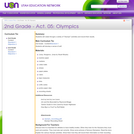
In this lesson students will rotate through a variety of "Olympic" activities and record their results.
- Subject:
- Arts and Humanities
- Material Type:
- Lesson Plan
- Provider:
- Utah Education Network
- Date Added:
- 10/22/2013

This lesson is designed as a supplemental or extension to the 2nd grade Smithsonian Science for the Classroom module titled How Can We Find the Best Place for a Plant to Grow? This lesson can be taught as an extension to Lesson 6: A GARDENER'S GADGET. This lesson is designed to facilitate student learning about sustainable design and green chemistry principles.
- Subject:
- Engineering
- Life Science
- Material Type:
- Activity/Lab
- Lesson
- Lesson Plan
- Teaching/Learning Strategy
- Author:
- Carissa Haug
- Date Added:
- 08/14/2024

Long Description:
Authors and editors: Haley Zanga, Audrey Boraski, Alana Olendorf, Marisa Benjamin, Haley Fantasia, Simone McEwan, Jaime Marsh, Melissa Wydra, Will Trautmann, Emily Michaeles, Maddi Ouellette, Andrew Fuhs, Allie Tolles, Suki Graham, Mary Swain, Devon Audibert, Sarah Larsen, Emma Verville, Tim Brodeur, Jason Charbonneau, Christian Paparazzo, Bryce Chounard, Malisa Rai, Jennifer Rosado, Morgan Tupper
Chief Editors, final revision: Haley Zanga, Audrey Boraski, Alana Olendorf
Chief Editor, first draft: Andrew Fuhs
Managing Editors and Editorial team leaders, first draft: Bryce Chounard, Emily Michaeles, Maddi Ouellette
Word Count: 40031
(Note: This resource's metadata has been created automatically as part of a bulk import process by reformatting and/or combining the information that the author initially provided. As a result, there may be errors in formatting.)
- Subject:
- Biology
- Life Science
- Date Added:
- 02/02/2024




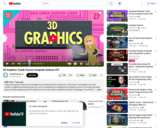
Today we’re going to discuss how 3D graphics are created and then rendered for a 2D screen. From polygon count and meshes, to lighting and texturing, there are a lot of considerations in building the 3D objects we see in our movies and video games, but then displaying these 3D objects of a 2D surface adds an additional number of challenges. So we’ll talk about some of the reasons you see occasional glitches in your video games as well as the reason a dedicated graphics processing unit, or GPU, was needed to meet the increasing demand for more and more complex graphics.
- Subject:
- Applied Science
- Computer Science
- Material Type:
- Lecture
- Provider:
- Complexly
- Provider Set:
- Crash Course Computer Science
- Date Added:
- 09/06/2017

Short Description:
An open textbook created to improve both teaching and learning vital concepts and techniques in multivariable calculus, one of the fundamental courses across the undergraduate curriculum in science and engineering. The goals of this resource are to help learners develop their geometric intuition about abstract and complex mathematical concepts (e.g., partial derivatives, multiple integrals, vector fields), and train them to make connections between concepts visually (e.g., connecting “vectors” in mathematics with “magnitude” and “direction” in physics) in order to more fully understand engineering, physics and mathematical problems (e.g., differential equations) in their subsequent STEM coursework.
Word Count: 7075
(Note: This resource's metadata has been created automatically by reformatting and/or combining the information that the author initially provided as part of a bulk import process.)
- Subject:
- Calculus
- Mathematics
- Material Type:
- Textbook
- Provider:
- Toronto Metropolitan University
- Date Added:
- 02/28/2022
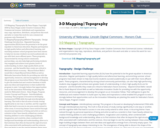
3-D Mapping | Topography
By Dana Hoppe, Copyright 2018 by Dana Hoppe under Creative Commons Non-Commercial License. Individuals and organizations may copy, reproduce, distribute, and perform this work and alter or remix this work for non-commercial purposes only.
Download: 3-D_MappingTopography.pdfDelete
Topography - Design Challenge
Introduction - Expanded learning opportunities (ELOs) have the potential to be the great equalizer in American education. Regular participation in high quality before and afterschool learning, and enriching summer school programs have been shown to help low-income students succeed academically on par with their more affluent peers. These programs, characterized by strong school-community partnerships, can also help high-performing students stay engaged and achieve even greater levels of understanding. In short, high-quality ELOs are for everyone - and the benefits they create are critical to Nebraska's future economy. - Beyond School Bells I would like to thank Beyond School Bells as well as Nebraska Innovation Studio for providing me with the opportunity, resources, and encouragement to develop this program as an Innovation Fellow. Their willingness to give the intellectual and creative freedom to build upon my ideas and inspirations is what enabled this program to exist. I strongly believe that opportunities such as the Innovation Fellowship are planting the seeds for Nebraska's future. -Dana Hoppe, Program Creator
Concept and Purpose - Interdisciplinary Learning: This program is focused on developing fundamental STEM skills through interdisciplinary learning. The truth is that all areas of study overlap significantly in one way or another, and the cognitive skills that lead to success in one area surely extend to other areas. A recurring theme I have noticed through my personal experience of being and artist as well as a scientist is that I have heavily utilized my creative thinking abilities to solve challenging problems. Imagination and creativity, when combined with background knowledge and understanding, allow us to find solutions that often lie beyond the rigid structure often associated with mathematics and the sciences. Once we begin to see the overlap between these areas, we begin building bridges between them and new ideas and applications emerge from a formerly empty space. The concept of topography was always interesting to me. The strangeness of being able to discern the shape of the land simply from the distance between a hypnotizing assortment of lines on a flat piece of paper was immediately intriguing. How does this flat sheet of abstract shapes translate to the three-dimensional complexity of a mountain, a valley, or a bluff? Topography is the platform of this program because it is a very versatile concept and can be used to create art and models representing a diverse range of fields. The activities in this program focus on having the students follow processes often found in Computer Science. Every process they complete can be thought of as an algorithm, and when they repeat steps, it can be thought of as a loop. They are also recursively calling the same function on each resulting piece they create, mimicking the concept of dynamic programing. The permutation matrix activities will familiarize students with moving through the data in a matrix and adding data to stacks. While they are doing all of these activities, however, there will be no jargon they have to learn, and they will probably not even realize until they take their first Computer Science course that it is even related. To the students, they will simply be creating art in a new and interesting way.
- Subject:
- Education
- Material Type:
- Activity/Lab
- Lesson
- Lesson Plan
- Date Added:
- 08/10/2019
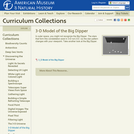
Students see firsthand that stars and constellations are not arranged in a flat, 2-D pattern in this Moveable Museum unit. The five-page PDF guide includes suggested general background readings for educators, activity notes, step-by-step directions, and a Big Dipper map. Students make their own 3-D models of the Big Dipper using readily available materials and examine their models, observing the 3-D constellation from new perspectives.
- Subject:
- Astronomy
- Physical Science
- Space Science
- Material Type:
- Activity/Lab
- Provider:
- American Museum of Natural History
- Provider Set:
- American Museum of Natural History
- Date Added:
- 10/15/2014
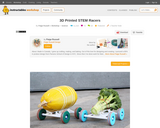
Create 3D printed components for a vegetable/fruit STEM racer!
From the article:
"These 3D printed STEM race cars are the perfect project based learning tool to help teachers get kids excited about science, technology, engineering, math, and nutrition to boot! The racers I show you how to make in this instructable will provide an opportunity to turn almost anything (no kittens or other live things please) into a race car – allowing different sized and weighted objects to illustrate mechanical physics concepts like mass, friction, force, speed, distance, and gravity!"
- Subject:
- Education
- Educational Technology
- Material Type:
- Activity/Lab
- Author:
- Paige Russell
- Date Added:
- 01/31/2020
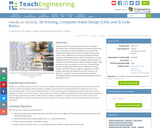
Students learn how 3D printing, also known as additive manufacturing, is revolutionizing the manufacturing process. First, students learn what considerations to make in the engineering design process to print an object with quality and to scale. Students learn the basic principles of how a computer-aided design (CAD) model is converted to a series of data points then turned into a program that operates the 3D printer. The activity takes students through a step-by-step process on how a computer can control a manufacturing process through defined data points. Within this activity, students also learn how to program using basic G-code to create a wireframe 3D shapes that can be read by a 3D printer or computer numerical control (CNC) machine.
- Subject:
- Applied Science
- Computer Science
- Engineering
- Geometry
- Mathematics
- Measurement and Data
- Material Type:
- Activity/Lab
- Provider:
- TeachEngineering
- Provider Set:
- Activities
- Author:
- Matthew Jourden
- Date Added:
- 05/04/2019
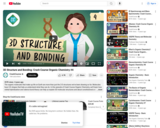
The organic molecules that make up life on Earth are more than just the 2-D structures we’ve been drawing so far. Molecules have 3-D shapes that help us understand what they can do. In this episode of Crash Course Organic Chemistry, we’ll learn how orbital hybridization and valence bond theory can help us explain 3D molecular structures and about constitutional and geometric isomers.
- Subject:
- Biology
- Chemistry
- Life Science
- Physical Science
- Material Type:
- Lecture
- Provider:
- Complexly
- Provider Set:
- Crash Course Organic Chemistry
- Date Added:
- 05/27/2020